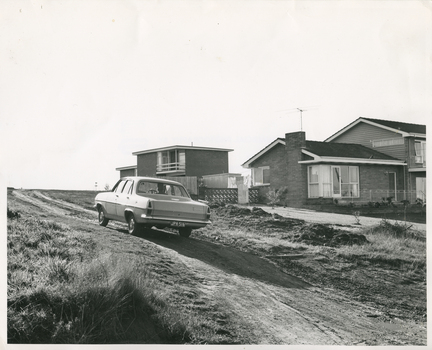Historical information
The photograph shows a RDNS Sister driving her RDNS car along a dirt road to reach a patient to administer nursing care. It shows the typical conditions of the roads the RDNS trained nurses encountered in some districts. The photograph also depicts an Australian made Holden car of the mid 1960s
Significance
Melbourne District Nursing Society, later Royal District Nursing Service (RDNS) has had various modes of transport over the last 130 years. At first their Trained nurses (Nurses) walked the streets and lane ways amid the slums of central Melbourne. As the Society expanded bicycles, public transport, District cars, the use of a Motor Auxiliary, the Trained nurses (Sisters) own cars, and even a motorcycle were used, and all these forms were intermingled until RDNS had its own fleet of vehicles. By 2009 there were 598 cars in the fleet and the Sisters travelled 9 million 200,000 kilometres – this is equivalent to 12 trips to the moon and back.
The Trained nurses of the Melbourne District Nursing Society (MDNS), later known as Royal District Nursing Service (RDNS), visited patients in their home and gave best practice care in many fields of nursing, and to people of many cultures, throughout its 130 years of expansion. Initial visits not only assessed the specific nursing situation but the situation as a whole. Their patients ranged in age from babes, children, adults to the elderly and referrals were taken from Hospitals, General Practitioners and allied Health facilities. Some of the care the Sisters provided is as follows: – Post-Natal care given to mother and babe, Wound Care following various types of surgery, accidents, burns, cancer, leg ulcers etc. Supervising and teaching Diabetic Care, including teaching and supervising people with Diabetes to administer their own Insulin, and administering Insulin to those unable to give their own injections. Administering other injections and setting up weekly medication boxes. The Sisters performed Catheterizations on adults suffering from conditions such as Quadriplegia, Paraplegia, Multiple Sclerosis (MS), Motor Neurone Disease (MND) and Guillan-Barre Syndrome, and when required at school on children for e.g. those with Spina Bifida. The Sisters visited those requiring Cystic Fibrosis support and care; those requiring Haemo-Oncology care, including visiting children at school; those requiring Home Enteral Feeding care, and those requiring IV therapy at home and home Dialysis. Palliative Care was given including pain relief with the use of syringe drivers, personal care as needed, and advice and support to both patient and family. The Sisters provided Stoma management to those needing Urostomy, Ileostomy and Colostomy care and those requiring Continence care. HIV/AIDS nursing care was provided; visits to Homeless Persons were made. Personal care was given to patients ranging in age and with varying mobility problems, such as those with MS, MND, Guillan-Barre Syndrome, Poliomyelistis, Quadriplegia, Paraplegia, Acquired Brain Injury, to those following a Cerebrovascular Accident (Stroke), those with severe Arthritis and those with a form of Dementia. When necessary the elderly were assisted with personal care and advice given on safety factors with the use of hand rails, bath or shower seats, and hand showers. Rehabilitation with an aim towards independence remained at the forefront of the Sister’s minds and when possible using aids and instruction on safe techniques enabled the person to become fully independent. All care included giving advice and support to the patient and their Carers. The Sisters liaised with the persons Doctor, Hospital and allied Health personal when necessary.
Physical description
In the centre of this black and white photograph is a Royal District Nursing Service, (RDNS), Sister at the wheel of her RDNS Holden car, which has a black rear Victorian number plate with 'JPH - 516' written in white letters. Through the back window you can see part of the Sister's uniform and her peaked hat worn over her short curled hair. Her left hand is on the upper part of the steering wheel. The dirt road on which she is travelling has mud and some grass tufts either side of it. On the right of the car is a hip roof brick house which has a single storey front area with attached two storey section at the rear. A short open Besser brick fence, with a white wooden gate, is seen running from the front of the property to the house, and beyond this a clothes line and shed. Beyond this, part of a tall paling fence is seen from the front of the property to the shed. The top section of the next brick house is seen beyond the fence; it has a white railed veranda along part of it and the house has a flat roof.
Inscriptions & markings
Photographers stamp. Quote No. GE 90

